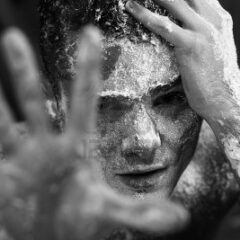Sep 27, 2011 | By Tim Stoddart
DMT Dimethyltryptamine
Hallucinogens AddictionStreet Names
Dmitri, Fantasia, Businessman’s Trip, Businessman’s Special, and 45-Minute Psychosis
Overview
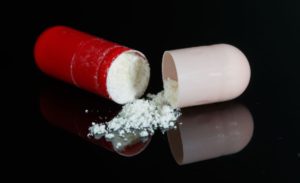 DMT formerly known as Diamethyltryptamine, is a white crystalline powder that is found in certain plants in Mexico, South America, and parts of Asia. DMT is a naturally occurring psychedelic substance,and scant amounts of it can be found in mammals’ brains. It can also be found in the intoxicating beverage “ayahuasca,” however, ayahuasca is sometimes brewed with plants that do not produce the substance. DMT is the strongest of all psychedelic drugs and is sometimes referred to as an “entheogen,” a word that means “god-generated-within.” The drug’s chemical structure is similar to that of the anti-migraine drug, “sumatriptan,” and has been known to smell vaguely like mothballs. The substance acts as a non-selective agonist at most of the serotonin receptors. DMT is not active when taken orally unless it is combined with another substance that inhibits it’s metabolism. DMT has been known to produce vivid mystical experiences involving euphoria and dynamic hallucinations of geometric forms, higher intelligences, extraterrestrials, elves, and God.
DMT formerly known as Diamethyltryptamine, is a white crystalline powder that is found in certain plants in Mexico, South America, and parts of Asia. DMT is a naturally occurring psychedelic substance,and scant amounts of it can be found in mammals’ brains. It can also be found in the intoxicating beverage “ayahuasca,” however, ayahuasca is sometimes brewed with plants that do not produce the substance. DMT is the strongest of all psychedelic drugs and is sometimes referred to as an “entheogen,” a word that means “god-generated-within.” The drug’s chemical structure is similar to that of the anti-migraine drug, “sumatriptan,” and has been known to smell vaguely like mothballs. The substance acts as a non-selective agonist at most of the serotonin receptors. DMT is not active when taken orally unless it is combined with another substance that inhibits it’s metabolism. DMT has been known to produce vivid mystical experiences involving euphoria and dynamic hallucinations of geometric forms, higher intelligences, extraterrestrials, elves, and God.
DMT is thought to potentially be produced naturally in small amounts by the human brain in developing fetuses, during deep R.E.M. sleep, and right before death, earning it the nickname of the “spirit molecule,” although research has yet to positively confirm this.
History
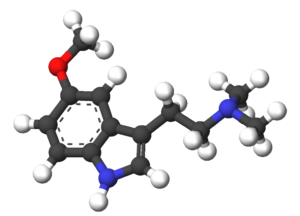 DMT has been historically been used in ancient cultures for ritualistic and healing purposes. The drug was first synthesized in 1931 by Richard Manske. At this time neither it’s effect on the human consciousness nor its presence in traditional South American indigenous admixtures were known, and so DMT was forgotten until some fifteen years later when investigations into plants containing DMT were captured much curiosity by ancient Shamans in South America. Although it’s presence was studied in South America, the psychoactive effects of DMT were not discovered until first reported by Stephen Szára in 1956. Szára was unable to obtain LSD or mescaline from the Swiss company Sandoz Laboratories due to the grounds that the powerful psychotropic could be dangerous in the hands of a communist country. Szára then synthesized his own DMT in hopes that it would turn out to be ‘psychedelic.’ The substance gained popularity as a drug of abuse in the 1960’s when it’s properties were widely made known. DMT was made illegal in 1966.
DMT has been historically been used in ancient cultures for ritualistic and healing purposes. The drug was first synthesized in 1931 by Richard Manske. At this time neither it’s effect on the human consciousness nor its presence in traditional South American indigenous admixtures were known, and so DMT was forgotten until some fifteen years later when investigations into plants containing DMT were captured much curiosity by ancient Shamans in South America. Although it’s presence was studied in South America, the psychoactive effects of DMT were not discovered until first reported by Stephen Szára in 1956. Szára was unable to obtain LSD or mescaline from the Swiss company Sandoz Laboratories due to the grounds that the powerful psychotropic could be dangerous in the hands of a communist country. Szára then synthesized his own DMT in hopes that it would turn out to be ‘psychedelic.’ The substance gained popularity as a drug of abuse in the 1960’s when it’s properties were widely made known. DMT was made illegal in 1966.
Statistics
DMT is classified as a Schedule I drug under the United Nations 1971 Convention on Psychotropic Substances, meaning it has a high potential for abuse as well as no accepted medical treatment in the United States. While hallucinogen use is not nearly as common among teens as alcohol, marijuana and prescription drug abuse, DMT is a still a drug that may be abused by youth. The Journal of Psychopharmacology published a global study profiling a large number of individuals which abused substances and found between November and December 2012, 8.9 percent reported they had tried DMT at least once in their lifetime. The study also found that DMT use creates desirable effects, which could indicate high abuse liability. The possibility for abuse, however may be degated by a low urge to reuse the drug.
Additionally, DMT had the highest prevalence of new users of hallucinogenic drugs, at 24 percent of those surveyed, indicating a potential rise in the drug’s popularity. The 2016 Monitoring the Future survey reported that 4.2% of high school seniors reported having used a hallucinogenic drug within the past year.
A 2016 report by the Drug Enforcement Administration stated that the effects and short duration of DMT are appealing to those who prefer a psychedelic experience. However, these individuals often do not choose to experience the mind-altering perceptions over an extended period of time.
How Is DMT Administered?
DMT can be typically consumed by vaporizing it or smoking it in a pipe, consuming orally in brews like ayahuasca, or snorting and injecting the drug. When inhaling the drug, effects can be felt by inhaling a couple of successive breaths. The effects last for a short duration of time, usually between 5 and 15 minutes dependent on the dose.
In short, DMT can be ingested in the following ways:
- vaporized or smoked in a pipe
- consumed orally in brews like ayahuasca
- snorted or injected
Why Do Individuals Take DMT?
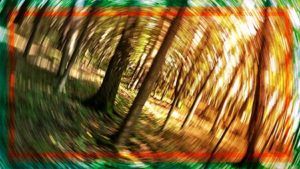 Historically, DMT has been used for religious rituals to induce states of detachment from reality, known to precipitate “visions,” thought to provide mystical insight or enable contact with a “higher power.” As of recent, users have reported using DMT for more social or recreational purposes. Some of the reasons can include: merely having fun, dealing with stress, or enabling them to enter a more enlightened sense of thinking or being – as perceived.
Historically, DMT has been used for religious rituals to induce states of detachment from reality, known to precipitate “visions,” thought to provide mystical insight or enable contact with a “higher power.” As of recent, users have reported using DMT for more social or recreational purposes. Some of the reasons can include: merely having fun, dealing with stress, or enabling them to enter a more enlightened sense of thinking or being – as perceived.
Although not proven, some hallucinogens like DMT have been investigated as therapeutic agents to treat diseases associated with perceptual disorders such as schizophrenia, obsessive-compulsive disorder, bipolar disorder, and dementia. Some reports have suggested that ayahuasca may be a potential treatment for additional mental health issues, but no large-scale research has verified it’s accuracy.
DMT And The Brain
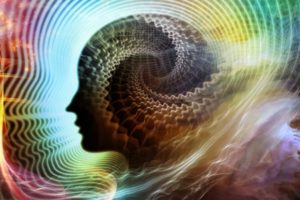 When someone takes DMT, which is considered a serotonin antagonist, the substance attaches to serotonin receptors, or otherwise increase its effectiveness at removing the GABA braking system. The result is neurological activity goes up in areas of the brain that use serotonin as a modulator. The altered state of consciousness that results is because of this increased activity. This causes neurons that would normally be triggered by the release of serotonin to fire when no actual serotonin is present.
When someone takes DMT, which is considered a serotonin antagonist, the substance attaches to serotonin receptors, or otherwise increase its effectiveness at removing the GABA braking system. The result is neurological activity goes up in areas of the brain that use serotonin as a modulator. The altered state of consciousness that results is because of this increased activity. This causes neurons that would normally be triggered by the release of serotonin to fire when no actual serotonin is present.
Short-Term Effects of DMT
It is difficult to predict how this substance will effect each person, however, DMT has a relatively short duration of action, intense effects and rapid onset.
When an individual is on the drug it can feel like days. The drug has been known to send users into a dreamlike state commonly referred to as “blasting off.” DMT “trips” are highly individual, as they are believed to originate from within a person’s subconscious. Sense of time, perception of colors, sounds, and other sensory, auditory, and visual stimuli may be altered while taking the drug. Heart rate and blood pressure may be raised and a user’s pupils will dilate on the substance. People who take DMT often report seeing extreme hallucinations, such as alien lifeforms, gods and past-life versions of themselves. These trips may include a number of terrifying and potentially dangerous experiences. Some users have trouble returning to the real world after using the drug.
Most often DMT causes vomitting, loss of bowel control, and a general “sickly” feeling, particularly in ayahuasca form.
Additional side effects can include:
- Hypertension
- Increased heart rate
- Agitation
- Dizziness
- Seizures
While DMT may be pleasant for select users, others can experience what is commonly referred to as a “bad trip.”
A “bad trip” can result in the following:
- Reliving painful memories
- Fear of going insane
- Disorientation or confusion
- Violent imagery or sounds
- Negative emotions such as fear, anger, anxiety or agitation
- Fear of death
Long-Term Effects of DMT
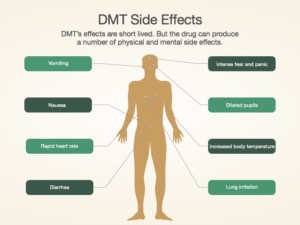
Persistently influencing the brain’s signaling systems can result in psychological addiction or dependence. This form of dependence is linked to emotional, motivational and personality changes and may not result in a physical substance abuse withdrawal symptoms.
Frequent use of the classic hallucinogens such as DMT can lead to persistent psychosis. Symptoms of persistant psychosis can include:
- Disordered mood.
- Disorganized thought.
- Persistent paranoia.
- Visual disturbances.
Risks Of Using DMT
Structurally, DMT is related to the neurotransmitter, Serotonin. Individuals who take antidepressants can be at risk of “Serotonin Syndrome,” which occurs when the body accumulates excessive amounts of the neurotransmitter. This condition can potentially become lethal when a user is on antidepressants and uses DMT.
Too much serotonin in the body can range in a multitude of symptoms, including:
- Agitation
- Confusion
- High blood pressure
- Headache
- Loss of muscle coordination
- At higher doses, DMT can lead to seizures, respiratory arrest, and coma.
DMT Addiction
 While DMT and hallucinogens are not generally considered to be physically addictive, the Substance Abuse and Mental Health Services Administration (SAMHSA) reported that in 2013 approximately 280,000 Americans battled a hallucinogen use disorder. Using DMT repetitively over time can, however, create a physical tolerance that will require users to take more of the drug to continue to feel its effects.
While DMT and hallucinogens are not generally considered to be physically addictive, the Substance Abuse and Mental Health Services Administration (SAMHSA) reported that in 2013 approximately 280,000 Americans battled a hallucinogen use disorder. Using DMT repetitively over time can, however, create a physical tolerance that will require users to take more of the drug to continue to feel its effects.
The first signs of addiction may include:
- Dilated pupils
- Nasea
- Tremors
- Uncoordinated eye movements
DMT addiction is largely psychological in nature and may be characterized or recognized by the following:
- Persistent thoughts regarding DMT use
- An inability to get drug use under control
- Continued use of the drug as although it interferes with daily functioning
- Participation in high-risk behaviors
- Abnormal interest in spirituality and religion
- Obsessing with exploring the world and self
How Do I Help My Loved One?
 Suspecting a loved one has a problem abusing DMT can be frightening. Remembering that you may not be able to control the behaviors or reactions of your loved one may help in times of chaos and frustration.
Suspecting a loved one has a problem abusing DMT can be frightening. Remembering that you may not be able to control the behaviors or reactions of your loved one may help in times of chaos and frustration.
Before speaking to your loved one about their addiction, you must wait until the effects wear off to confront them. A couple of things to remember before confronting your loved one include:
- Taking a nonjudgmental stance – This is crucial. There’s no doubt that any sort of confrontation can be difficult, however in this case the addict can come off defensive and abrasive. Taking a nonjudgmental stance can save much frustration and headache.
- Remain calm – You as well as your loved one are in a vulnerable state. Seek to understand the perspective of your loved one and try your best to display empathy.
- Educate yourself – Educate yourself on the effect that DMT can have on users as well as treatment options before getting into a full conversation. Be prepared.
- Encourage – Encourage your loved one to get the help they need. While treatment is potentially challenging. Send positivity their way by letting them know you think they can achieve sobriety.
DMT Treatment
There are many types of treatments for DMT addiction. The most important decision for anyone battling a this issue can make is to seek treatment. Addiction is a serious issue and should not be taken lightly. If you are struggling with DMT dependence and abuse it is crucial that you receive help at a drug treatment center.
 The road to recovery is difficult and traverse but there are many who have successfully reached long term sobriety. Methods of self-control can be taught during group therapy sessions. Individual and group evidence-based therapy sessions may utilize therapies, such as cognitive behavioral therapy, or CBT, which seeks to determine the events, circumstances, or psychological causes of addiction while helping to find new and healthier ways to manage potential stressors or life triggers.
The road to recovery is difficult and traverse but there are many who have successfully reached long term sobriety. Methods of self-control can be taught during group therapy sessions. Individual and group evidence-based therapy sessions may utilize therapies, such as cognitive behavioral therapy, or CBT, which seeks to determine the events, circumstances, or psychological causes of addiction while helping to find new and healthier ways to manage potential stressors or life triggers.
In short, inpatient facilities often offer a controlled environment usually needed in the early stages of recovery as well as a wide variety of therapies which can include:
- Cognitive Behavioral Therapy
- Dialectical Behavioral Therapy
- Individual Therapy
- Family Counseling
- Group Therapy
- Holistic Therapy
Most treatment facilities offer 30-day, 60-day, or 90-day programs. The length of time an individual stays can depend on the severity of their addiction or insurance provider.
Fully-trained staff will conduct an evaluation and interview before intake. Note that they should address polydrug abuse and all co-morbid disorders as well.
Counseling and case management is beneficial when treating addiction. This is because it gives us a chance to explore the underlying cause of the addiction. These include the personal problems and triggers behind substance abuse. Doctors recommend behavioral therapy for DMT addiction. This is because it provides structure and goals to the individual.
The next step in the treatment of DMT dependence is aftercare. It will include support groups and 12-step programs. This can give the addict a sense of belonging and re-socialization.
Addiction is a progressive disease, and if not treated can be fatal. In order to fully recover from its devastating effects you need to understand all the effects as well as all of your available options. As the leading provider of information regarding addiction and treatment on the internet, the experienced staff at Sober Nation are able to provide you with the information and support you need to break the cycle of addiction. Regardless of where you live, how much money you have, or how severe your addiction is, there is a treatment center that can help you recover. Don’t wait another day. Contact Sober Nation today.
 Although DMT is a potent drug that leads to psychological addiction, you can achieve a sober life.
Although DMT is a potent drug that leads to psychological addiction, you can achieve a sober life.
For treatment options contact our 24 hour helpline at: 866-317-7050

